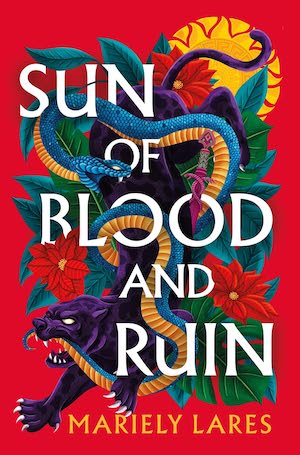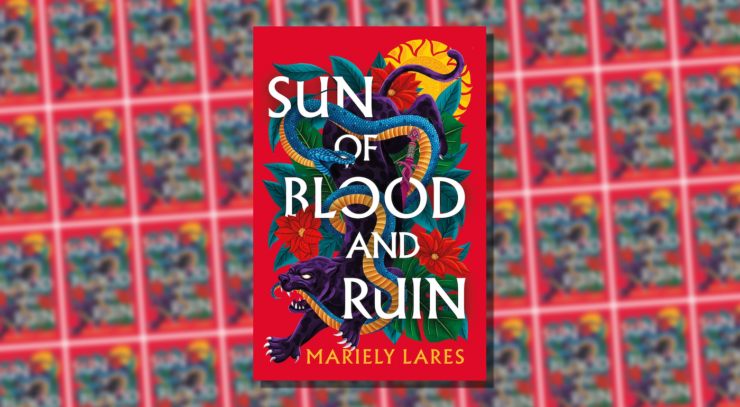I’ll admit it. I wanted to read Sun of Blood and Ruin because it’s marketed as a reimagining of Zorro featuring a swashbuckling sorceress. 1998’s Mask of Zorro was my first PG-13 movie and I loved it, despite being forever haunted by that head in a jar scene (iykyk). My inner adolescent’s attachment to that film may have brought me to Mariely Lares’ debut novel, but her story is so much more than a twist on the classic Zorro legend—though at times, almost too much more.
Set in sixteenth century New Spain, which is present-day Mexico, Sun of Blood and Ruin is the first in a duology. It is narrated by eighteen-year-old Leonora, a noblewoman whose elegant façade hides her double identity as folk hero Pantera. The daughter of the first viceroy of New Spain and the Mexica woman he loved, Leonora is caught between worlds even when she isn’t wearing the panther’s mask. For while the book is speculative history, the horrors of colonialism remain central. The regime of New Spain seems determined to crush the indigenous people of the land—the Nahuas, a term encompassing the seven tribes of the area. As a member of the court led by her fourteen-year-old half-brother, Viceroy Jerónimo, and his scheming mother vice regent, Leonora is a political voice for the native residents. As Pantera, our heroine meets violence with violence, fighting in the streets against the cruel Captain Nabarres and his persecution of all who adhere to Nahua ways.
Pantera’s power itself grows from the world depicted in indigenous lore. As a girl, Leonora wandered away from the palace and was lost in the forest for ten years. During this time she lived in Tamoanchan, a mythological paradise where she was trained as a Nagual—a shapeshifter. Though Pantera did not complete her training, she returned to the city able to wield her tonalli (life force) in battle, shift into a panther, and cross swords with the best of them.
The novel begins with both Pantera and Leonora in crisis. As Pantera, our protagonist fails to save a beloved local wise man from Nabarres, and loses her magical Sword of Integrity. As Leonora, she faces an unwanted betrothal to the Crown Prince of Spain, which will take her away from her land and her calling. In both guises, our narrator was born during the cursed Nemontemi, the Dead Days at the end of the year, and is thus destined to die young in battle. As the prophesied collapse of the Fifth Sun approaches, Leonora-Pantera can feel her violent fate drawing nearer—not to mention the end of the world at the hands of demons and vengeful goddesses. Over the course of the following 350 pages, this multifaceted character navigates political intrigue, meets a roguish guardsman with tonalli too powerful to be what he seems, discovers the truth about her betrothed, goes in search of the indigenous resistance La Justicia, and negotiates with the gods themselves.
Buy the Book


Sun of Blood and Ruin
Lares’s intricate plot is a wonder, full of surprising connections and revelatory twists. She unfolds the sumptuous world of the book with care and patience, weaving new aspects of magic and startling creatures throughout the story. Her extensive research is brought to visceral life, and I felt she held my uninformed hand just enough. I appreciated that Lares guides this many-layered story to a satisfying conclusion, her only indication of a sequel being a rather filmic teaser scene at the very end.
Yet, this astonishing plot would be more suited to two or even three novels. The disguised folk hero and revolution narrative would be enough to fill the covers of a book, as would the saga of the gods’ cyclical struggles over the fate of humanity. With so much richness crammed into one book, every event is on the heels of the one before. I quickly became overwhelmed by revelations and lightning-quick action sequences, and couldn’t slow down to appreciate the characters’ arcs or the dazzling settings. At one point in the novel, a character seems to die, only to reappear five pages later; within those same five pages, a new character is introduced and the main character has a major revelation about her inner self. As this sequence might suggest, some character development is lost to the demands of this juggernaut of a plot, which is frustrating when the characters have been so well set up.
I came away from all this hoping Lares’ duology gets optioned for TV someday, despite the fact that I’m not much of a TV person. If I got the conflicted Pantera and a universe shaped by Quetzalcoatzin instead of another medieval Europe-inspired fantasy epic, I would be glued to that screen. Lares’ ideas are magnificent, but I craved more immersiveness, which actors and production design could provide. Though my love of Zorro might seem to inform my desire for such an adaptation, by the final page of this gripping and original tale, I’d forgotten all about him. Sun of Blood and Ruin presented a world and characters I desperately wanted to get lost in, but its frenetic pace and overambitious scope wouldn’t quite let me.










